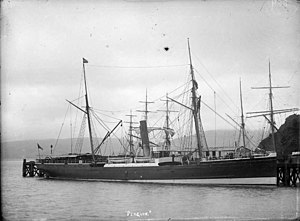SS Penguin
 SS Penguin at Port Chalmers.
Photograph by David Alexander De Maus. | |
| History | |
|---|---|
| Name | SS Penguin |
| Owner |
|
| Builder | Tod and Macgregor, Glasgow |
| Yard number | 128 |
| Launched | 21 January 1864 |
| Identification | Official number: 47849 |
| Fate | Sank on 12 February 1909 after colliding with rocks near Wellington. 75 people killed in what is classed as New Zealand's deadliest maritime disaster. |
| General characteristics [1] | |
| Type | Passenger/cargo steamship |
| Tonnage | |
| Length | 220 ft 6 in (67.21 m) |
| Beam | 28 ft 6 in (8.69 m) |
| Depth | 14 ft 4 in (4.37 m) |
| Propulsion |
|
| Speed | |
SS Penguin was a New Zealand inter-island ferry steamer that sank off the southwest coast of Wellington after striking a rock near Sinclair Head in poor weather on 12 February 1909. Penguin's sinking caused the deaths of 75 people, leaving only 30 survivors. This was New Zealand's worst maritime disaster of the 20th century.[2]
Ship history[edit]
Penguin was built by Tod & McGregor of Glasgow, Scotland, for G. & J. Burns of Glasgow, and launched on 21 January 1864. Registered in Glasgow on 4 April 1864, she was finally sold to the Union Steamship Company in 1879, and was extensively refitted in 1882.[1]
In 1904, a passenger aboard the SS Penguin tried to shoot a dolphin named Pelorus Jack with a rifle, leading to Jack becoming the first individual sea creature protected by law in any country.[3]
Sinking[edit]
Penguin departed Picton on 12 February 1909 en route to Wellington in good conditions. However, the weather conditions changed by 8 pm, with very strong winds and bad visibility. At 10 pm, Captain Francis Naylor headed farther out to sea to wait for a break in the weather, but the ship smashed into Thoms Rock while making the turn, and water started to pour in. Women and children were loaded into the lifeboats, but the rough seas dragged the lifeboats underwater; only one woman survived, and all the children were killed. Other survivors drifted for hours on rafts before reaching safety. As the Penguin sank, seawater flooded the engine room. The cold water reached the boilers, and a massive steam explosion violently fractured the ship.[4]
Following the disaster, a half-day holiday was declared in Wellington to allow the many funerals to be held,[5] as some 40 people were laid to rest in Karori Cemetery.
A court of inquiry found that the ship struck Thoms Rock near the mouth to Karori Stream in Cook Strait. The captain maintained that it had struck the submerged hull of the Rio Loge, lost the month before.[6] On the 100th anniversary of the sinking, Wellington's mayor unveiled a plaque at Tongue Point, near the site of the wreck.[7]
References[edit]
- ^ a b "SS Penguin". Clyde-built Ship Database. 2013. Archived from the original on 3 September 2004. Retrieved 31 January 2013.
{{cite web}}: CS1 maint: unfit URL (link) - ^ The 1863 sinking of HMS Orpheus remains New Zealand's deadliest maritime disaster.
- ^ Pelorus Jack fact sheet Archived 21 May 2010 at the Wayback Machine at the Museum of Wellington
- ^ "SS Penguin – New Zealand Disasters". Christchurch City Libraries. 2013. Retrieved 31 January 2013.
- ^ "SS Penguin wrecked in Cook Strait". nzhistory.net.nz. 2013. Retrieved 31 January 2013.
- ^ Wood, Stacey; McDonald, Greer (11 February 2009). "Search for wreck of Penguin". The Dominion Post. Retrieved 11 May 2012.
- ^ SS Penguin Sinking to be Remembered on South Coast, Wellington City Council, 9 February 2009.
Further reading[edit]
- Collins, Bruce (2000). The Wreck of the Penguin. Wellington: Steele Roberts Limited. ISBN 1-877228-28-1.
External links[edit]
- "The Sinking of the SS Penguin: Passenger and Crew Lists". freepages.genealogy.rootsweb.ancestry.com.
